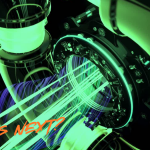The Sharp Edge of Light
The Rise of Lasers in Autonomy, Defense, and Industry
There’s much more to Optics Valley than just optics. It’s about the technologies that harness, shape, and control light from lasers and photonics to advanced sensors and manufacturing tools that define the modern world. While the University of Arizona’s Wyant College of Optical Sciences anchors a global reputation for precision optics, the region’s influence extends across industries: autonomous systems, defense innovation, and industrial automation, all powered by laser technology.
From mapping the surface of Mars to welding spacecraft components, lasers are defining the next era of precision and innovation. The three most transformative areas where lasers lead today are LIDAR, Directed Energy, and Industrial Manufacturing, each showing how light can become a tool of intelligence, protection, and creation. Our tech hub is the home of over 100 companies producing optics and photonics solutions. One of our companies, Photonics Automation Specialties, produces laser burn-in racks that can test the lifecycle of high-power lasers.
LIDAR: Eyes of the Autonomous World
If autonomous vehicles are the brains of modern robotics, then LIDAR Light Detection and Ranging is their eyes. LIDAR systems send out pulses of laser light and measure how long it takes for those pulses to bounce back from surrounding objects. This creates a detailed, three-dimensional picture of the environment that is accurate within a few centimeters.
This technology has become a cornerstone for autonomous navigation on Earth and in space.
Autonomous Vehicles
Self-driving cars rely heavily on LIDAR to “see” their surroundings. The laser beams sweep across roads, scanning buildings, pedestrians, and obstacles in real time. These reflections create 3D maps that help vehicles decide when to safely turn, stop, or accelerate. The same principle applies to drones and industrial robots that navigate complex environments where GPS or cameras may not work well.
Aerospace and Space Exploration
NASA and private companies like SpaceX and Blue Origin also use LIDAR in their missions. For instance, NASA’s Mars missions use LIDAR to map the planet’s surface and identify safe landing zones. During spacecraft docking maneuvers, laser rangefinders help two vehicles align precisely in orbit, a task that requires millimeter accuracy.
Agriculture and Mining
In agriculture, LIDAR-equipped drones are becoming powerful tools for precision farming. They analyze crop heights, soil erosion, and canopy density, helping farmers make better irrigation and fertilizer decisions. LIDAR systems map underground tunnels and open pits in mining to improve safety and efficiency.
Urban Planning and Infrastructure
City planners use LIDAR data from airplanes and satellites to create digital twins, virtual copies of cities. These 3D models help design better roads, manage utilities, and predict flood zones. When combined with AI, LIDAR allows cities to simulate traffic patterns, plan renewable energy layouts, and monitor climate effects.
Emerging Trends
The future of LIDAR lies in solid-state systems, smaller, cheaper devices without moving parts. They use semiconductor lasers and optical phased arrays, making them ideal for mass-market use in cars, drones, and smartphones. When fused with AI and machine learning, these systems can interpret environments instantly, turning data into real-time decision-making tools.
As LIDAR becomes more affordable, it will drive self-driving cars, smart infrastructure, and advanced robotics, effectively giving machines vision.
Directed Energy: The Next Frontier in Defense
The idea of a “laser weapon” once belonged to science fiction. Today, directed-energy systems are becoming a reality. These systems focus high-powered laser beams onto targets, transferring massive amounts of energy at the speed of light. The result is precise, nearly instantaneous engagement without gunpowder, explosives, or conventional ammunition.
Missile and Drone Defense
Modern battlefields face a growing challenge: fast, low-cost threats like drones and small missiles. Traditional interceptors can cost hundreds of thousands of dollars per shot. Laser defense systems change that equation.
For example, the U.S. Navy’s HELIOS (High Energy Laser with Integrated Optical-dazzler and Surveillance) system uses powerful lasers to disable drones and small boats. The U.S. Army’s DE M-SHORAD (Directed Energy Maneuver-Short Range Air Defense) system does the same for ground-based units, burning through incoming projectiles before they reach their targets. Each “shot” costs only pennies in electricity compared to missiles.
Iron Beam and the “Golden Dome”
Israel’s Iron Beam and Golden Dome projects push laser defense even further. Instead of kinetic interceptors, these systems use optical tracking and photonic power to shoot down rockets and mortars mid-flight. They promise to complement traditional missile shields like the Iron Dome with faster response and lower cost per engagement.
Satellite and Space Defense
In orbit, lasers have strategic uses too. They can blind enemy sensors without causing permanent damage or even disable satellites through directed heating. However, under international treaties, most nations have agreed to restrict destructive laser use in space.
Emerging Trends
The most significant breakthroughs in directed energy come from fiber lasers and diode-pumped solid-state lasers, which convert electrical energy into powerful, focused light with high efficiency. Adaptive optics technology that adjusts a beam in real time to counter atmospheric distortion helps maintain accuracy over long distances.
The next challenge is miniaturization: developing compact, rugged systems that can operate on aircraft, ships, and ground vehicles. Once solved, directed-energy systems could defend cities, bases, and borders with beams of light, no gunpowder required.
Industrial Manufacturing: Where Light Builds the Future
While LIDAR gives machines sight and directed energy gives them strength, industrial lasers are the hands that shape modern civilization. In factories worldwide, lasers cut, weld, and engrave materials with micrometer precision, creating everything from cars and aircraft parts to microchips and medical implants.
Laser Cutting and Welding
Traditional mechanical cutting and welding use physical contact, which causes wear and introduces heat distortion. Lasers, by contrast, can cut metal, plastic, and composites cleanly using light alone. Fiber and CO₂ lasers dominate industries like aerospace, automotive, and shipbuilding, where accuracy and consistency are essential.
In welding, laser beams fuse materials faster and cleaner than traditional methods, producing smaller heat-affected zones. The result: stronger joints, less rework, and higher production speeds.
Additive Manufacturing (3D Printing)
Lasers are at the heart of metal 3D printing, also known as laser sintering or laser melting. They melt powdered metal layer-by-layer to form complex parts that would be impossible to make using standard machining. This technique reduces waste, saves weight, and enables on-demand manufacturing from aircraft components to medical implants tailored to individual patients.
Semiconductor and Microelectronics
In microelectronics, lasers etch the tiny circuits that power smartphones and computers. They’re also used in photolithography, a process that defines patterns on silicon wafers for semiconductor chips. As devices get smaller and faster, ultrashort-pulse lasers operating in femtoseconds (quadrillionths of a second) allow engineers to process materials without heat damage.
Marking and Engraving
Every product that needs a serial number, barcode, or logo benefits from laser marking. Laser engraving is permanent, precise, and tamper-proof, unlike ink or paint. It’s used across industries for product traceability, compliance, and brand protection.
Emerging Trends
The industrial future belongs to AI-controlled laser systems. Artificial intelligence can adjust laser parameters in real time for perfect cuts, welds, or engravings, reducing errors and downtime. Meanwhile, femtosecond and picosecond lasers process delicate materials like glass or polymers without cracking them, which is critical for modern electronics and medical devices.
As smart factories embrace Industry 4.0, lasers will become fully automated tools that communicate with sensors, robots, and AI platforms, transforming manufacturing into a seamless digital ecosystem.
Conclusion: The Light That Shapes Progress
Lasers are far more than bright beams; they’re tools of transformation. In the air, they give machines sight through LIDAR. In defense, they protect lives through directed energy. On factory floors, they build the future with precision and efficiency.
Each pulse of light represents control, power, and progress, symbolizing how science can harness energy to solve humanity’s toughest challenges. From Optics Valley Tech Hub to other research centers, the laser revolution continues to expand, lighting the way for safer, smarter, and more advanced technologies across every industry.








